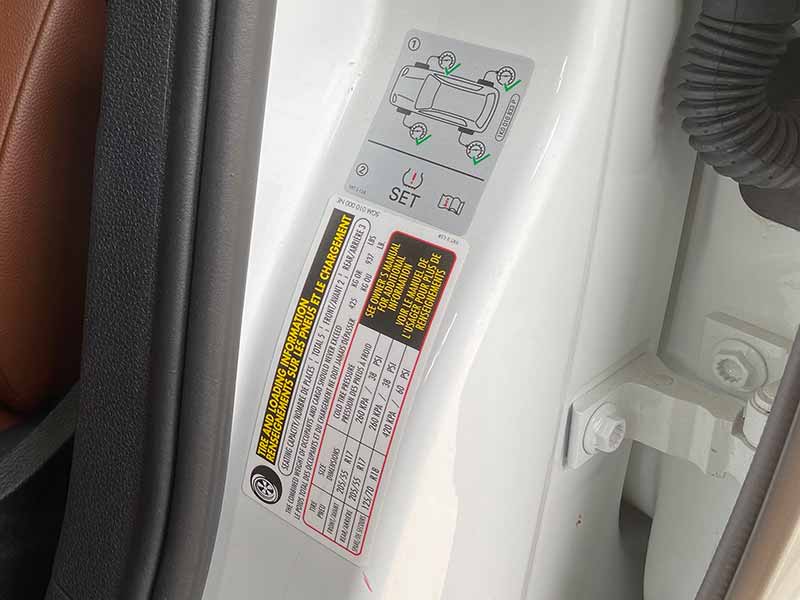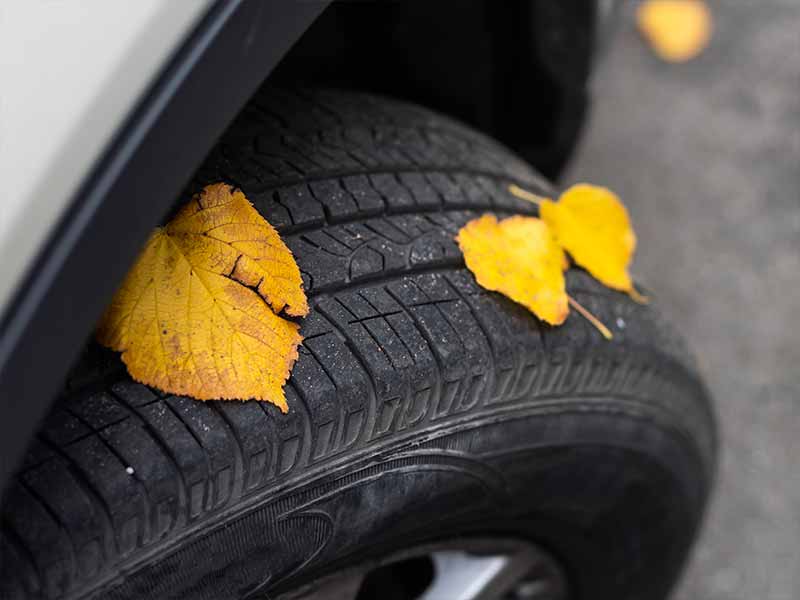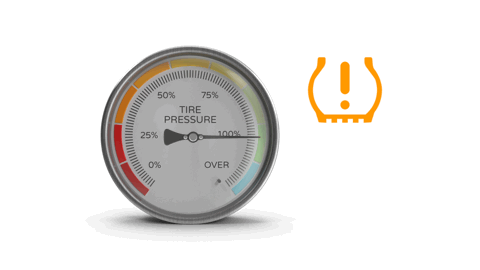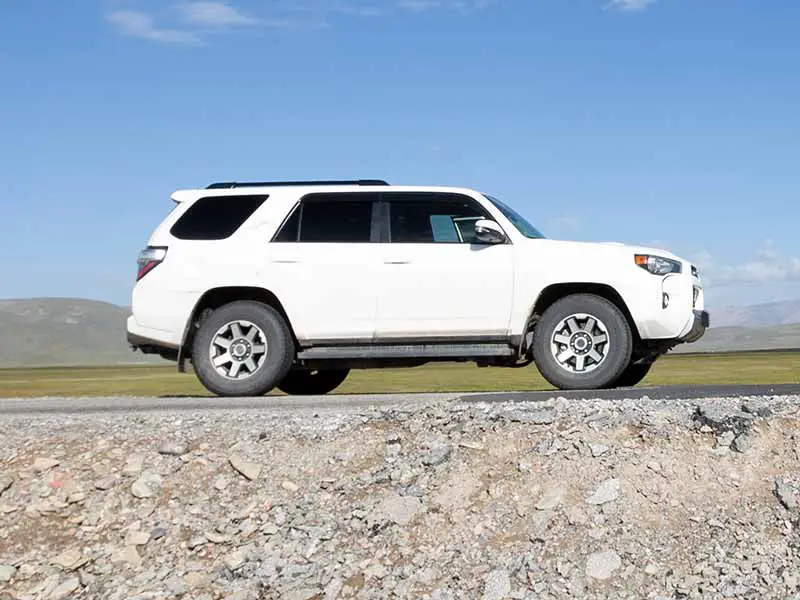You know that feeling when you’re cruising down the open road, your favorite tune on the radio, not a care in the world? And then, BAM! You’re jolted back to reality by a little yellow warning light on your dashboard – your air pressure is low. Ugh, right?
Tire pressure may seem like a minor detail in the grand scheme of car maintenance, but it’s a crucial aspect that keeps you safe and your ride smooth on the road.
Normal Tire Pressure For SUV Tires
The normal tire pressure for SUV tires typically ranges between 30 to 40 PSI. However, the ideal tire pressure can vary based on the vehicle’s make, model, and the specific tire specifications.
Always refer to the owner’s manual or tire information sticker found in the driver’s door jamb for the correct tire pressure.
In this article, we’re taking a deep dive into everything you need to know about tire pressure. From understanding what tire pressure really means to finding the right tire pressure for your SUV, adjusting for seasonal changes, and how to check and inflate your tires properly. We’re also tackling common questions about tire pressure.
Let’s take a closer look.

Understanding Tire Pressure
Tire pressure, simply put, is the amount of air in your tire. It’s usually measured in PSI, which stands for Pounds per Square Inch. Think of it like this – if you have a small box that’s one inch by one inch, and you put a weight of one pound in it, that’s 1 PSI. When it comes to tires, it’s the amount of air pressure inside the tire that can support a pound of weight.
Now, you might think – the more air, the better, right? That’s where many people can get tripped up. Tires are a bit like Goldilocks and her porridge – you want the pressure to be just right. Too high or too low, and you can run into problems.
So, Is 40 PSI Good for SUV Tires?
Well, the answer isn’t as straightforward as you might think. There’s a common misconception that there’s a ‘standard’ tire pressure for all cars or all types of vehicles. But that’s not quite the case. Every vehicle is different, and so are its tires.
Your SUV might need a tire pressure of 40 PSI, or it might need something different. It all depends on factors like the type of tire, the weight of the vehicle, and the vehicle manufacturer’s recommendations.
What’s important to remember here is that while 40 PSI could be right for some SUVs, it’s not a magic number that works for all. It’s essential to check your vehicle’s manual or the sticker usually found on the driver’s side door jamb to know the exact recommended tire pressure.
The Maximum PSI Rating – It’s Not What You Think
When you look at the sidewall of your tire, you’ll see a bunch of numbers and letters. One of them is the maximum PSI rating. This is the highest pressure that the tire can safely handle. But hold up – it doesn’t mean you should inflate your tire to this number for your regular driving.
The maximum PSI is more like a safety limit, not a target to hit. If you inflate your tires to their max PSI, you’ll likely make your ride uncomfortably bouncy and decrease the lifespan of your tires. It could also put you at risk of a tire blowout. So, remember, max PSI is a limit, not a goal.

Determining The Right Tire Pressure For Your SUV
The first step is finding the recommended pressure for your vehicle. No, this isn’t a quest or a treasure hunt. It’s as simple as checking two places:
- Your vehicle’s manual: This handy book should be in your glove box, and it’s packed with info about your car. Flip through it to find the section on tire pressure. It’ll tell you exactly what PSI your tires should be at.
- The driver’s side door jamb: If you open the driver’s door and look at the panel on the side of the car (that’s the door jamb), you’ll likely see a sticker or a placard. This sticker has info about the tire size and the recommended tire pressure.
Understanding The Relationship Between Max PSI and Your SUV’s Tire Pressure
Now, we’ve already talked about max PSI. Remember, that’s the highest pressure your tire can handle, not what you should inflate it to. But how does it relate to your SUV’s recommended tire pressure?
Think of it like this. If your tire’s max PSI is the top of a mountain, your vehicle’s recommended tire pressure is a comfortable campsite lower down. It’s the spot where you have the best balance between comfort, safety, and performance. You could go higher, but why risk it when you have everything you need right there?
Why Not Inflate To The Max PSI?
Inflating your tires to the max PSI might seem like a good idea. More air, more support, right? Not exactly.
If you overinflate your tires, you’re stretching the rubber and the internal components more than they’re designed to handle. This can lead to a rough ride because overinflated tires don’t absorb road bumps well. It could also increase the risk of a tire blowout if you hit a pothole or a sharp object on the road.
On top of that, overinflated tires tend to wear out unevenly. The center will wear out faster than the edges, which means you’ll need to replace the tire sooner.
Tire Pressure Adjustment In Different Seasons
Ever noticed how a beach ball feels softer in cold water and firmer in the sun? Well, something similar happens with your SUV’s tires in different seasons.
How Cold Weather Affects Your Tire Pressure
It’s a fact of life: when it gets colder, air contracts. This means the air inside your tires shrinks a bit, and your tire pressure drops. It’s not a huge change, but it can be enough to affect your vehicle’s handling and safety.
That’s why it’s crucial to check your tire pressure more often in the winter. If it’s dropped below the recommended level, you’ll need to add some air. You’ll get better traction on snowy or icy roads, and you’ll be safer too.
Adjusting Tire Pressure For Winter Conditions
So, how do you adjust your tire pressure for winter? It’s pretty straightforward. If your tire pressure has dropped below the recommended PSI, just add enough air to bring it back up to the right level.
Keep in mind that your garage might be warmer than the outdoors. If you adjust your tire pressure in the garage, you might want to add a little extra to account for the colder temperature outside.
Regular Checks During Seasonal Changes
Checking your tire pressure should be part of your regular car maintenance routine. But it’s especially important when the seasons change. The transition from summer to winter can lead to a significant drop in tire pressure, and the shift from winter to summer can do the opposite.
So when the leaves start to fall or the first buds of spring appear, make a date with your tire pressure gauge. Your SUV will thank you for it!

How To Properly Inflate Your SUV Tires
So now that we’ve gone over all the theory, it’s time for the hands-on part: how do you check and adjust your tire pressure? Grab your tire pressure gauge and let’s get started!
Step-By-Step Guide To Checking And Adjusting Your Tire Pressure
- Get a Reliable Tire Pressure Gauge: These little devices are affordable and easy to find at any auto parts store. You could use the gauge at a gas station air pump, but having your own is better. It’s more accurate and lets you check your tire pressure at home or on the road.
- Check Your Tires When They’re Cold: Tires heat up when you drive, which can increase the tire pressure. For the most accurate reading, check your tire pressure in the morning before you’ve driven anywhere, or at least three hours after you’ve last driven.
- Remove The Valve Cap On Your Tire: The valve is where you add air to the tire. It’s covered by a small cap to keep out dirt and dust. Unscrew this cap and set it aside. Don’t lose it!
- Press The Gauge Onto The Valve Stem: The valve stem is the little metal pin inside the valve. Push the end of the pressure gauge onto it. You’ll hear a hiss of air, but don’t worry – it’s supposed to do that.
- Read The Tire Pressure: Your gauge will give you a reading in PSI. If it’s below the recommended level for your SUV, you’ll need to add some air.
- Add Air To The Tire: You can do this at a gas station air pump or with a home air compressor. Add a little air at a time, then check the pressure again. Repeat until your tire pressure is at the recommended level.
- Replace The Valve Cap: Screw the cap back onto the valve. This keeps out dirt and helps prevent air leaks.
Ensuring Even Tire Pressure Across All Four Tires
When you’re checking and adjusting your tire pressure, make sure to check all four tires. It’s important for all of them to have the same pressure (unless the manufacturer recommends otherwise). Uneven tire pressure can make your SUV handle oddly and wear your tires out unevenly.

I Recommend Every Keep A Portable Air Compressor In Their Car Or Truck
Understanding The Low Tire Pressure Warning Light
The tire pressure monitoring system (TPMS) in your vehicle monitors the pressure in your tires. If the pressure in one or more tires falls below a certain level (usually about 25% below the recommended tire pressure), the TPMS will trigger the low tire pressure warning light.
What To Do When The Low Tire Pressure Warning Light Comes On
When you see this light, it’s time to take action. Here’s what to do:
- Don’t Panic: This isn’t a warning that you’re about to have a blowout. It’s just letting you know that one or more of your tires is underinflated and you should take care of it soon.
- Check Your Tire Pressure: Using a tire pressure gauge, check the pressure in each tire. Compare it to the recommended tire pressure for your vehicle.
- Inflate Your Tires: If your tire pressure is lower than the recommended level, add air until it’s at the right pressure.
- Check For Tire Damage: While you’re at it, give your tires a once-over for any signs of damage like cuts, punctures, or bulges. If you see any, get the tire checked out by a professional.
The low tire pressure warning light is there to help you, so don’t ignore it. Keeping your tires properly inflated is an easy way to ensure a safer and more comfortable ride, improve your fuel efficiency, and extend the life of your tires

Resources
Below are some links you may find helpful when learning about tires
- How do I find the correct SUV tire pressure? – Continental Tire
- Recommended tire pressure for your tires – Pirelli
Final Thoughts
The key takeaway here is that the ideal tire pressure for your SUV isn’t a fixed number – it can depend on factors like your vehicle’s make, model, and tire specifications. The golden rule is to stick to the tire pressure recommended by your vehicle’s manufacturer, usually found in the owner’s manual or the sticker on the driver’s side door jamb.
Good luck and happy motoring.





